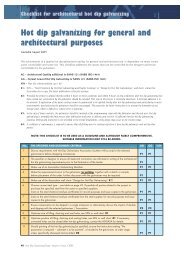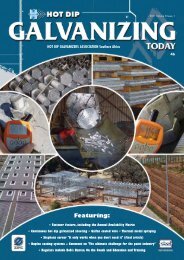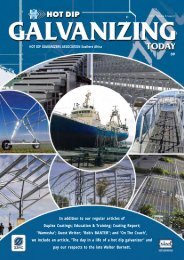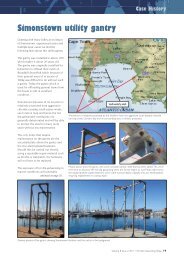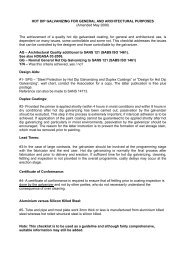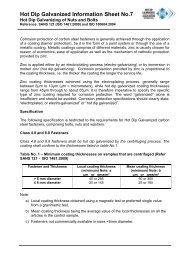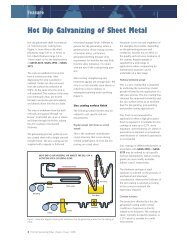HDGASA V7E1.pdf
HDGASA V7E1.pdf
HDGASA V7E1.pdf
- No tags were found...
You also want an ePaper? Increase the reach of your titles
YUMPU automatically turns print PDFs into web optimized ePapers that Google loves.
W amoshaPhoto 12. Photo 13. Photo 14.Photo 15. Photo 16. Photo 17.Tube hot dip galvanizing is generallydone to SANS 32 (EN10240) whichrequires a minimum coatingthickness of 55µm and because theprocess generally includes nonreactivesteel tubing and an exit airring.As the tube exits the zinc bath,via the air-ring, it is mechanicallywiped on the outer surface and thisensures that coating thicknesses fargreater than 55µm are unlikely.The specific building (No. 1) in thispark (photo 19) is situated alongsideCapricorn Drive and is reported to be2 1 /2 years old, while another building(No. 2) is closer to the coast and is 4 1 /2years old (photo 20).M5 GateBuilding No. 1Building No. 2Coastal GateNote: The location and position(relative to the coast line) of the twobuildings shown on the plan (photo18) are not necessarily 100% accuratebut have been shown merely toillustrate the corrosivity of the areawith respect to the coast line anduse of hot dip galvanized steel.Building No. 2Photo 21 shows the raker support armsfor the roof on Capricorn Road side.Photo 22 shows the hot dip galvanizedrafters and purlins. The only corrosionis on the painted barge plate (circled).Photo 23 shows the residual coatingthickness (177µm) on the rakersupport arm wall plate.Photo 24 shows the appearance of thetubular raker support arm on seawardside (note the chloride deposit) whilephoto 25 shows the appearance landwardside (note less chloride deposit). Photo26 (179µm) and photo 27 (149µm) showthe landward side coating thickness.Photos 28 and 29 (119 and 121µm,respectively) show the seaward sidecoating thickness. Note the significantresidual coating thickness differencebetween the two faces after 4 1 /2 years.Building No. 1As expected the hot dip galvanizedsteel components on the South Eastand South West face of the buildingappear to be the worst affected, withconsiderable performance differencesbetween the hot dip galvanized roofrafters and bracing (to SANS 121) (seephotos 36 - 40 and 47 - 50) and thecontinuously hot dip galvanizedpurlins (to SANS 3575 or 4998) (seephotos 30 - 35 and 41 - 46).South east corner and eavesPurlinsPhoto 30 is general, photo 31 shows theconcerns on the purlins and photos 32Approximateposition of coastlinePhoto 18. Photo 19. Photo 20.34 Hot Dip Galvanizing Today Volume 7 Issue 1 2010



